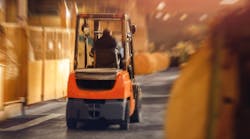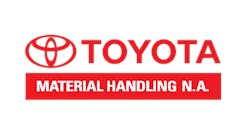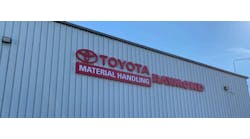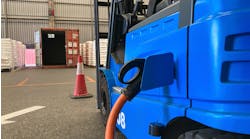Meeting Increased Safety and Performance Demands for Today’s Forklifts
Until recently, demand for advanced material handling equipment had been growing steadily. However, the extended COVID pandemic has had an unprecedented and devastating impact on manufacturing and the ability of manufacturers to move products. This, in turn, resulted in a negative demand shock for forklift trucks across all regions.
The adoption of advanced technologies on forklifts, however, is suggesting that sales will stabilize in the near-term to pre-pandemic levels and then grow over the foreseeable future. In the U.S. in particular, the passage of the trillion-dollar infrastructure bill means significant increases in projects that will require the use of more modern material handling equipment. Not only will these newer trucks move materials, but they will also be used to monitor and track the performance of operators, as well as mechanical and power systems.
Some of the bigger trends shaping new material handling technologies include:
• Increased focus on operational safety, which is driving changes in ergonomics and machine design.
• Rapid adoption of autonomous vehicles, which is in response to a need to control operational costs and respond to the current labor shortage.
• Growing interest in emerging IoT applications that offer user-friendly telematics and critical data analytics to improve productivity.
• Adoption of electric machines and alternative fuel technologies in response to stricter environmental mandates and a desire to limit potentially hazardous emissions.
Today’s forklift trucks not only look different than predecessor models, but they also perform at a much higher level of efficiency and productivity. Let’s look at some of the more noteworthy enhancements that have made this possible.
Over-the-Sheave Hose Designs
One of the most common sources of forklift repairs are leaks, with a large percentage of forklift leaks being attributed to a worn hose or tubing. Leaks are not only costly, but also potentially dangerous. Installing a hose with superior abrasion resistance and flexibility can extend the life of the hose by allowing it to stand up to the strains of continual flexing over sheaves. Since products being transported are likely to shift while on the forklift, this can cause additional stress and abrasion. In addition, the tight bend radius created by the sheave puts additional stress on the hose. High-performance hoses are required for side-shifter, power tilt, power steering, pump supply and other lift truck functions.
Programmable Display Modules
Competition for qualified lift truck operators has never been stiffer. This has led to greater demand across market segments for lift truck components that can improve both the ease and safety of material handling operations. In addition to being easy to use, electronic displays must withstand extreme temperature changes, vibration and EMC/EMI conditions.
Today’s compact, easy-to-read, full-color touchscreen displays with graphical programming capabilities support multiple languages and enable rapid applications and customized menu screen development. Some advanced systems even feature NTSC.PAL video capabilities or built-in CAN and I/O to help with remote trouble shooting.
Spin-on Filter Solutions
Keeping fluid systems clean is key to ensuring predictable performance while enabling planned maintenance intervals to increase uptime. A simple, effective approach to reducing maintenance downtime is the use of spin-on filters that make change-outs fast and easy. Today’s spin-on filter technologies provide reliable, cost-effective performance in a lightweight, compact package. When considering various spin-on filter designs, be sure to choose a supplier that has a variety of mounting and port options, as well as interchangeable canister heads. Easy-to-read gauges additionally help operators quickly assess operating conditions and predict maintenance needs.
Programmable Tactile Feedback Drives (TFDs)
TFD steering units are key components of fully electric and electric-hydraulic systems. They can accurately characterize the operating profile of the vehicles with an integrated solution that combines bearing support, steering position sensing, communication and continuously variable resistive steering torque.
Permanent Magnet Electric Motors and Inverters
Optimizing power density is critical when designing for drive train applications on electric or hybrid-electric vehicles. Permanent magnet motors and inverters provide maximum torque in a smaller, lighter package. They can achieve breakthrough levels of performance in applications where size and weight are significant design considerations.
Emerging Alternative Power Source Technologies
Reducing emissions is a key initiative for most industries that rely on forklifts across the world today. Many companies and governments have set clear milestone goals to achieve carbon neutrality by certain deadlines. Hydrogen has been identified as a good option for accomplishing these goals since hydrogen fuel cell technology harnesses the power of hydrogen with the efficiency of an electric operation. It also significantly reduces downtime by minimizing refueling time. Added benefits include zero emissions, space efficiency and a smooth, consistent power delivery. Furthermore, forklifts primarily operate in small areas such as warehouses, only limited hydrogen refueling stations are required.
With improvements in electric forklift technology, users can get up to two full shifts of runtime on a single battery charge. As a result, according to ITA data, electric now makes up 64% of the North American lift truck market.
Energy Recovery
There is ongoing research to explore various design options that allow for the storage and recovery of energy that comes from the lowering of the mast. As one proposed option, the lifting system is controlled directly with an electric servo motor drive and a hydraulic pump capable of operating also as a hydraulic motor during potential energy recovery.
Smart Sensors
Limited visibility is a major problem for forklift operators. A challenge is that, on most forklifts, the mast is designed toward the front of a forklift and directly in the operator’s line of vision. In addition, rear visibility is extremely limited, which is a problem when forklift trucks are backing up.
Lasers and sensors are especially critical for extending operator vision and enabling automatic guided vehicles (AGVs) to travel safely. In addition, 2D LIDAR navigation technology is providing added intelligence to allow AGV forklift trucks to navigate warehouses and distribution centers more safely and quickly. Direct connections between the AGVs and warehouse management systems is further enhancing safety and maneuverability. Should a forklift still hit something, major manufacturers have developed special impact sensors which alert operators when the forklift has hit something in order to minimize potential damage.
Noise and Vibration Mitigation Components
Noise is a serious issue both in warehouses and on construction sites where forklifts are often used. In both environments, noise is additive, which means it originates from a variety of sources and is amplified to create a significant noise level that is often above what the Occupational Safety and Health Administration (OSHA) considers safe for human hearing. As a result, extensive research has been done on ways to minimize various forms of noise. For example, silent fixed-displacement gear pumps have proven effective in applications that require noise levels to be less than 65cb but which require high power density.
High-Performance Thermal Interface Materials
Heat is an ongoing concern for battery packs on electric vehicles because it reduces battery charging rates, increases battery charging time, and can lead to damage of temperature-sensitive batteries. Thermally conductive structural adhesives and an array of newer encapsulation materials can help optimize heat dissipation.
Ancillary Performance-Enhancing Components
In an effort to decrease costs, minimize downtime, and extend the service life of the forklift, every component (regardless of size) should be evaluated to ensure that it is specially designed to offer a performance advantage. Specific examples include:
• Reliable, leak-free seals that have been optimized for high-pressure, vibration and impulse environments.
• Non-spill couplings that connect and disconnect hydraulic fuel lines quickly with minimal spillage and limited air inclusion.
• Zero-leak mobile directional control valves that deliver quick response, minimize heat generation and are flexible enough for a full range of tough mobile applications.
• Robustly designed analog lever sensors for boom and mast positioning in outdoor and other extreme applications.
• Highly efficient electric motors and controllers to solve the next forklift design challenge.
Demand for forklifts is not only expected to grow by the number of trucks, but also in the sophistication of the technology. Additional safety sensors, smart controls, easy-to-use programmable displays, predictable performance, increased productivity, IoT connectivity and environmental safety are only a few of the benefits being demanded by today’s operators.
Per A. Nilsson is an industry market manager for Parker, a provider of motion and control technologies. Nilsson focuses on the material handling markets globally.



